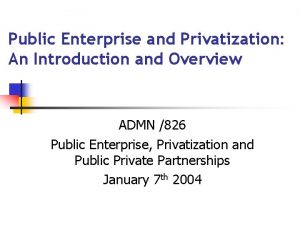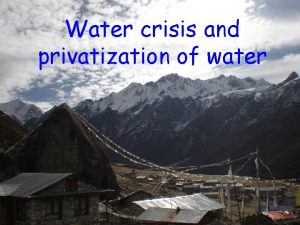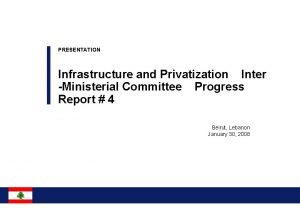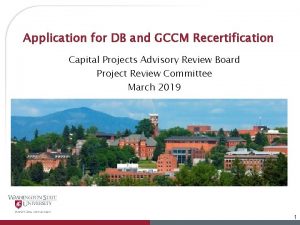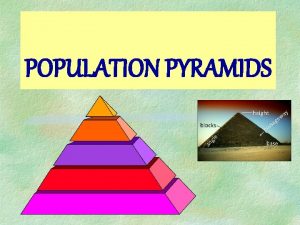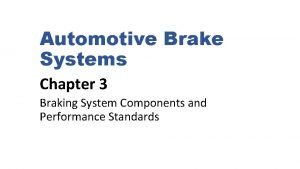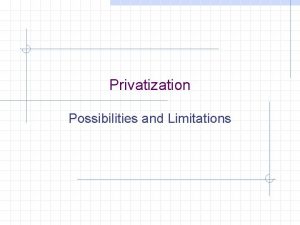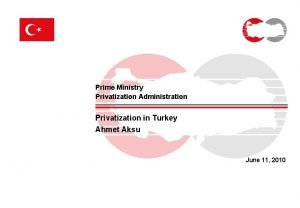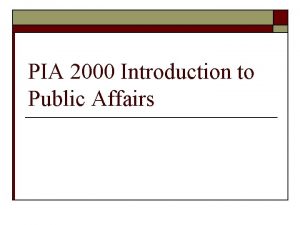PIA 2734 Skills Course Privatization and Contracting Out









































- Slides: 41

PIA 2734: Skills Course Privatization and Contracting Out

Methodology �Step One: Mini-Lecture- An Overview of Issues �Step Two: Work Group Identification of Major findings from the Readings �Step Three: Presentation of Brief Findings from Each Group (Two-Three Groups)

Discussion: Review of Syllabus

Overview The Knowledge and Skills Base for Domestic Service Delivery, International Assistance and Security

The Initial Problem Models of Social Services Systems: The Context of Privatization and Contracting

Overview Concepts: New Public Management Principles �Social Services- Delivery �Re-inventing Government- Customer vs. Citizen �Subsidiarity- Decentralization �Privatization: Private or Non-Profit Sector �Contracting Out- Extending Governance out of Government

U. S. Government Performance and Results Act of 1993

Boundary Valuation Problem: The Key to Privatization

Service Delivery Systems and Categories of Service Delivery �Issue of “size”: hard services or soft with capital or recurrent costs �Macro--Physical Services � Highways, Sewerage Main Lines, Electricity � Deconcentrated or Privatized �Micro--Physical Services � Devolved or Delegated

Focus of Stimulus Spending-Jobs

Service Delivery Systems and Categories of Service Delivery �Issue of “size”: hard services or soft with capital or recurrent costs �Social Services--Health, Education or Community Development (such as Social Funds) � Delegated or Contracted � Grants and Sub-Grants to Non-Profits �Investment or Production � Privatized � Public Private Partnerships

Note: Non-Profit Role in Service Delivery

Service Delivery Systems and Categories of Service Delivery Private Provision �Use of conventional Markets �Contracts with public agencies �Monopoly Franchises �Management Contracts �Vouchers �Consumer Cooperatives

Monopoly Franchises

Alternative Service Delivery Systems: Decentralization �Confederation- Lower level Units Dominate: European Union and other regional associations �Federal Relationship �Some power lies with National Unit �Some power lies with lower units

Alternative Service Delivery Systems �Federal Relationship �Key distinction: � Lower units cannot break away from National Unit � National � Under Units cannot take power away from lower units Federalism: One can transfer additional authority back to sub-units but not take power from federated governments


Alternative Service Delivery Systems �Federal Relationships �Examples �USA �Canada �Germany �Nigeria �India �Russian �Austria Federation �Switzerland �Malaysia


Alternative Service Delivery Systems �Unitary Systems and Sub-regional units �All power ultimately lies at national level �Local level power is given by national level �Power that national unit has given to local level can also be taken from it

Unitary Systems

Alternative Service Delivery Systems �Unitary Systems and Sub-regional units �Examples � United Kingdom � France � Kenya � Ivory Coast � South Africa? � Japan


Forms of Decentralized Service Delivery in Unitary Systems �Concept: �Transfer of authority to a lower level of government �Primary Unit of Government: �Lowest level that carries a bureaucracy with it


Forms of Decentralized Service Delivery in Unitary Systems �“Devolution”: Transfer to non-Federal political body �Budget and personal authority to district and town councils �Key--power lies with lower level politicians

Future Devolution?

Forms of Decentralized Service Delivery in Unitary Systems �De-concentration: Transfer to non-Federal political body �Transfer of authority to administrators at lower level within the administrative system �Delegation �Public Corporations or parastatals �Privatization- Ideological Debates



Deconcentration

Forms of Decentralized Service Delivery in Unitary Systems �Program and Project Decentralization: �Sectoral - By regular line or agency within a. Ministry � e. g. Focused activity - seed production (Green Revolution) � agricultural experiments and extension


Forms of Decentralized Service Delivery in Unitary Systems �Program and Project Decentralization: �Deconcentration or Devolution of authority to central level special unit � e. g. Water, health, emergency or education activities or projects to subordinate administrative or council structures � Port authorities


Forms of Decentralized Service Delivery in Unitary Systems �Program and Project Decentralization: �Inter-Ministerial Committees or Units � Planning supervision � Overlapping memberships, e. g. Land Use Planning


Forms of Decentralized Service Delivery in Unitary Systems �Program and Project Decentralization: �Creation of field level Special Project Units with semi- autonomous status � Range Management project � Integrated Rural Development

Integrated Rural Development- IRD �Most well-known type of special project: �Special designated geographical areas �Multitude of project activity in different sectors that may overlap or compliment

IRD Principles

Break and Group Sessions Develop Strategy for Report Backs
 Disadvantages of privatization of government services
Disadvantages of privatization of government services Privatization of water
Privatization of water Privatization
Privatization One direction one thing
One direction one thing Course title and course number
Course title and course number Uo purchasing and contracting
Uo purchasing and contracting Some common trafficking in persons contract violations
Some common trafficking in persons contract violations Interpersonal process issues in entering and contracting
Interpersonal process issues in entering and contracting Exblowra trading and contracting
Exblowra trading and contracting Intrapersonal skill
Intrapersonal skill Sof skill
Sof skill Sailor course brick
Sailor course brick Course interne course externe
Course interne course externe Put out the light then put out the light
Put out the light then put out the light Teejan contracting
Teejan contracting Contract matrix template
Contract matrix template Contracting state meaning in aviation
Contracting state meaning in aviation Nrcg contracting for fire
Nrcg contracting for fire Contoh penerapan psak 72
Contoh penerapan psak 72 Contingency contract definition
Contingency contract definition Universal fencing contracting
Universal fencing contracting Contingency contract definition
Contingency contract definition Af chain of command
Af chain of command Brute construction services
Brute construction services Huff contracting
Huff contracting Contracting company
Contracting company Con360
Con360 External expanding brake
External expanding brake Rectangle population pyramid
Rectangle population pyramid Braking system components
Braking system components What macromolecule is used for contracting muscles? *
What macromolecule is used for contracting muscles? * Theater business clearance
Theater business clearance Job order contracting 101
Job order contracting 101 Performance work statement example
Performance work statement example Business plan for government contracting
Business plan for government contracting Government contractor financing
Government contractor financing Rulemaking process steps
Rulemaking process steps Contracting squadron 36
Contracting squadron 36 Kelstone contracting
Kelstone contracting Chief contracting officer
Chief contracting officer Contracting 101 presentation
Contracting 101 presentation Job order contracting texas
Job order contracting texas
